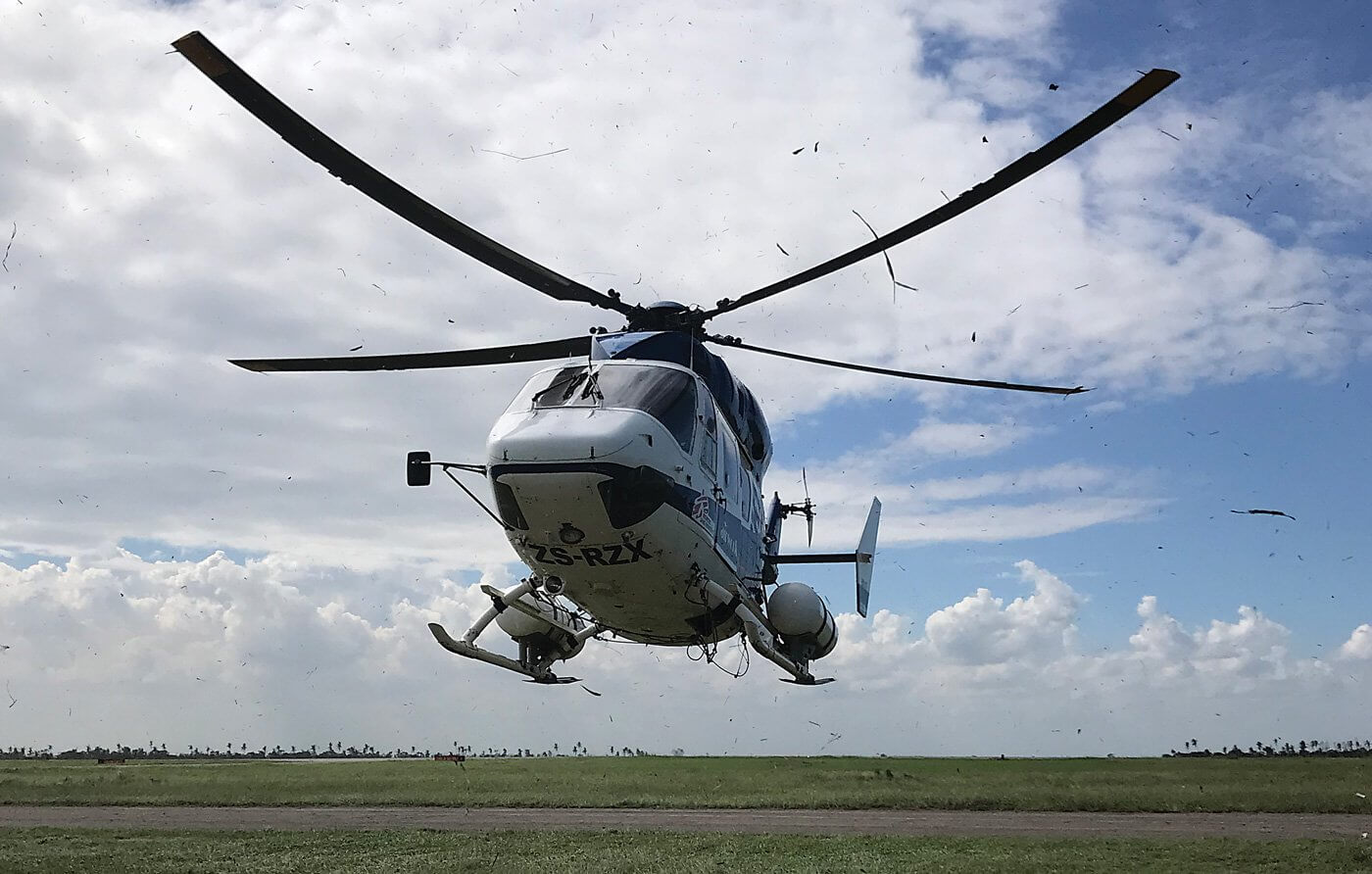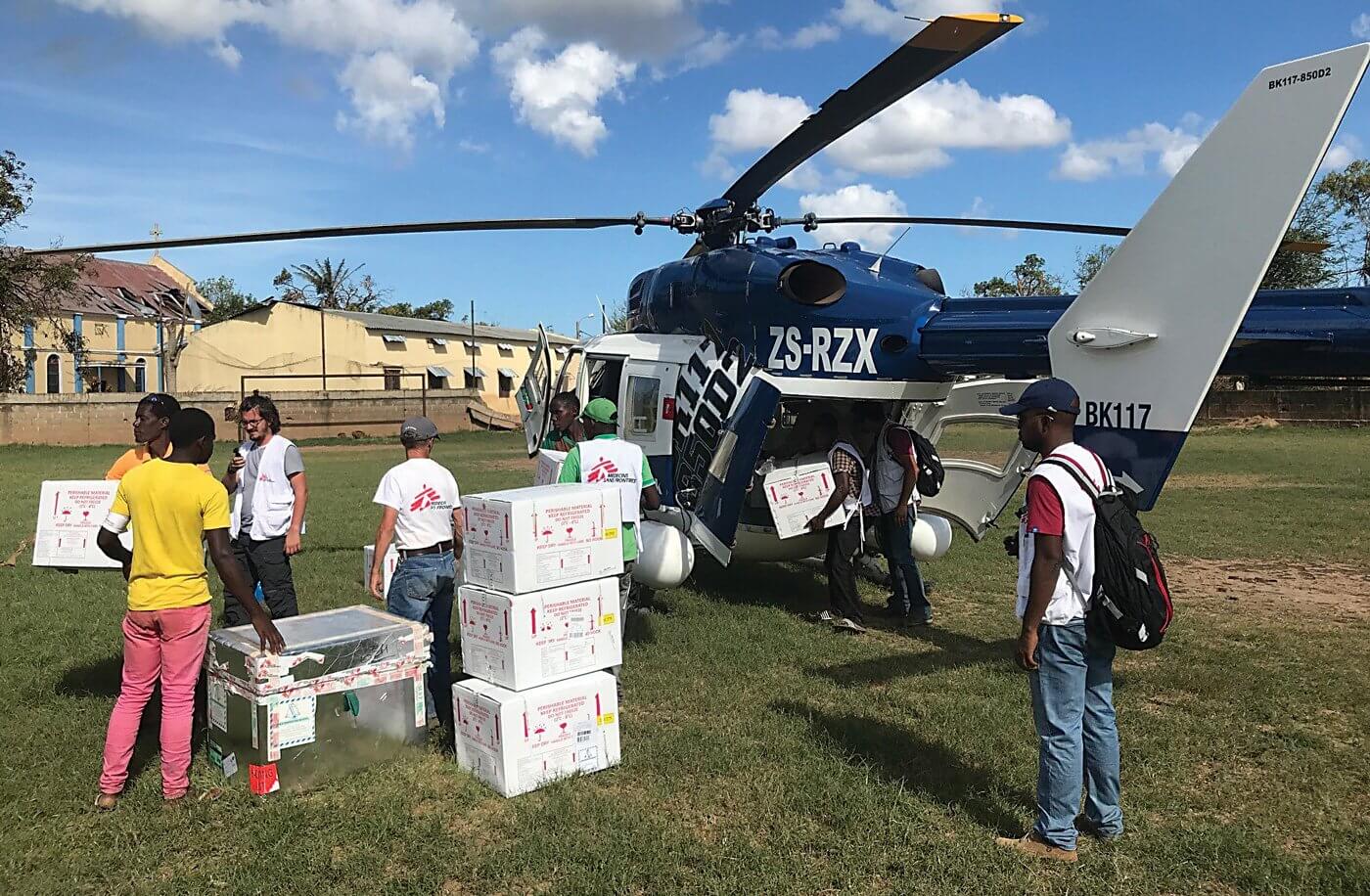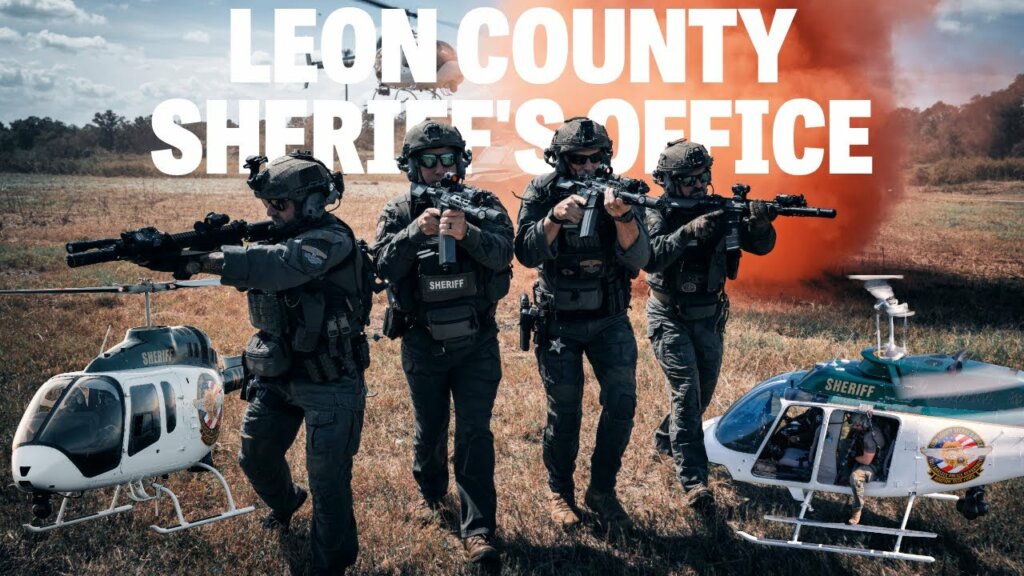On March 14 and 15, 2019, Cyclone Idai–one of the most destructive storms to ever strike the Southern Hemisphere–made landfall near Beira, Mozambique. In all, the tropical cyclone killed more than 600 people, injured over 1,600 and left millions in need. In addition to the vital infrastructure, schools and health centers lost, hundreds of thousands of homes were also destroyed. Neighboring Zimbabwe and Malawi were devastated, too, adding to the toll on the region.
 To help with relief efforts, global aid agency Médecins Sans Frontières (Doctors Without Borders) contracted Airwork to provide aviation services from the port city of Beira. Two helicopters and crews, initially led by Mike Hall, Airwork’s Commercial Director (helicopter leasing and operations), spent a month in Mozambique conducting missions and delivering a range of humanitarian aid.
To help with relief efforts, global aid agency Médecins Sans Frontières (Doctors Without Borders) contracted Airwork to provide aviation services from the port city of Beira. Two helicopters and crews, initially led by Mike Hall, Airwork’s Commercial Director (helicopter leasing and operations), spent a month in Mozambique conducting missions and delivering a range of humanitarian aid.
Prior to deployment, Airwork did a lot of research and talked to its contacts throughout Africa and Mozambique. The information it received painted a pretty bleak picture but prepared Airwork for what its teams would be facing.
An engineer from the company’s Ardmore base in Auckland, New Zealand, was dispatched immediately to prepare the aircraft. Hall–a veteran commercial pilot who recently won Aviation New Zealand’s Individual Award for dedication, commitment and contribution to aviation–was en route to South Africa for other Airwork business and was able to step into the flying role. He was soon joined by some of the company’s South African based captains and co-pilots.
 This ability to deploy critical support staff instantly is a vital company strength and a testament to Airwork’s agility and resource depth.
This ability to deploy critical support staff instantly is a vital company strength and a testament to Airwork’s agility and resource depth.
The aircraft, both BK117-850D2s, were each fitted with two external fuel tanks, giving both a maximum range of 350 nautical miles (648 kilometers). This extended range was especially useful in remote areas, where fuel was scarce. It also meant that supplies and medical personnel could get to affected areas that were further afield more quickly–and even allowed the helicopters to reach all the way to the border with Zimbabwe.
The lifting capability of the BK117-850D2 allowed each aircraft to carry over a tonne (2,200 pounds) of supplies in a single flight, depending on fuel load. Heavy items, such as water filtration and sanitization systems, medical supplies, and portable hospitals, could be transported together with aid personnel quickly and safely. The multi-role capability of both helicopters also meant that, when needed, each one could accommodate a medical stretcher, freight barriers and a variety of different seating configurations. Simply put, the D2 version of the BK-117, a model for which Airwork holds the STC, was the ideal aircraft to put to work in the aftermath of a natural disaster.
 “I was stunned at the level of damage,” said Hall, which was “partly a result of buildings not being built well and the 180-kilometer-per-hour winds, and a little shocked at the flooding that had occurred. . . . Once you get outside Beira, you’re pretty much talking about thatched housing. Houses just went with the winds. . . . A lot of people drowned and whole villages [were] gone.
“I was stunned at the level of damage,” said Hall, which was “partly a result of buildings not being built well and the 180-kilometer-per-hour winds, and a little shocked at the flooding that had occurred. . . . Once you get outside Beira, you’re pretty much talking about thatched housing. Houses just went with the winds. . . . A lot of people drowned and whole villages [were] gone.
“What happens in floods is the wildlife goes where it likes. Hippos and crocodiles were particularly dangerous. . . . They have large wildlife populations in Mozambique. Snakes try to seek dry ground, as well, so there were a lot of snake issues.
“Food was a big issue for people, with crops destroyed and the sea really muddy for those on the coast [removing fish as a possible food source]. Some places we went to people were desperate for food. That wasn’t very pleasant and heightened the security risks for staff. But most people were accommodating and grateful for the help.”
 Aside from obtaining fuel, the main impediments Hall and his teams faced revolved around getting good information and the right intel, so the correct supplies could be flown out. It was very complicated to co-ordinate aid packages. This was made even harder with multiple agencies participating in the relief efforts and teams facing unknown conditions in many areas of the country.
Aside from obtaining fuel, the main impediments Hall and his teams faced revolved around getting good information and the right intel, so the correct supplies could be flown out. It was very complicated to co-ordinate aid packages. This was made even harder with multiple agencies participating in the relief efforts and teams facing unknown conditions in many areas of the country.
“Landing was often difficult due to wet and boggy ground, debris, and built-up areas, and always people, including lots of children, desperately welcoming the aircraft and the support it was carrying,” said Hall.
However, the maneuverability of the BK117, along with its smaller rotor diameter and high tail, allowed it to land in most areas, ensuring aid could be easily offloaded and dispatched. Where landing wasn’t possible, supplies were carried in cargo nets on a long line and lowered to support teams already on the ground.
Airwork’s experience in these difficult operating environments was key to the success of each mission in Mozambique. That experience has helped the company develop an excellent safety management system, gives it the ability to make complex operational assessments and ensures its teams are well-rehearsed and -prepared to deal with complex situations.
 The difficulties with aid missions lie not in dealing with the actual issues but in understanding and determining what the issues are in the first place and then implementing strategies to address those concerns. Airwork’s robust processes have been applied to similar situations in the past, including when its teams operated in the Republic of Guinea for the duration of the Ebola crisis.
The difficulties with aid missions lie not in dealing with the actual issues but in understanding and determining what the issues are in the first place and then implementing strategies to address those concerns. Airwork’s robust processes have been applied to similar situations in the past, including when its teams operated in the Republic of Guinea for the duration of the Ebola crisis.
“There is a fairly lengthy risk assessment,” said Hall, “which is a formalized process and if that fails in certain areas, then we will turn things down because we can’t ensure those risks can be managed appropriately.”
That strategic and safety-focused approach, along with its personnel, experience and resources, is central to how Airwork can rise to the challenge of almost any mission requirement.









